Analysing Technology & Innovation Impact on Sainsbury's Work Culture
VerifiedAdded on 2023/06/14
|12
|923
|389
Report
AI Summary
This report examines the impact of new technology and innovation on the organizational work culture of Sainsbury's, focusing on the concepts of workplace innovation and digitalization. It discusses the benefits of implementing new technologies, such as becoming a market leader and improving employee retention, while also addressing the challenges associated with technology implementation. The research employs a qualitative approach, collecting primary data through questionnaires from Sainsbury's employees. The findings highlight strategies for mitigating challenges, such as rewarding employees and promoting teamwork, and emphasize the effectiveness of qualitative research in improving decision-making processes. The report concludes that embracing innovation and digitalization is vital for enhancing workplace culture and provides insights into how retailers can overcome barriers to technology implementation. Desklib offers a wide range of similar reports and solved assignments to aid students in their studies.

Assignment 2: Research Methodology
Paraphrase This Document
Need a fresh take? Get an instant paraphrase of this document with our AI Paraphraser
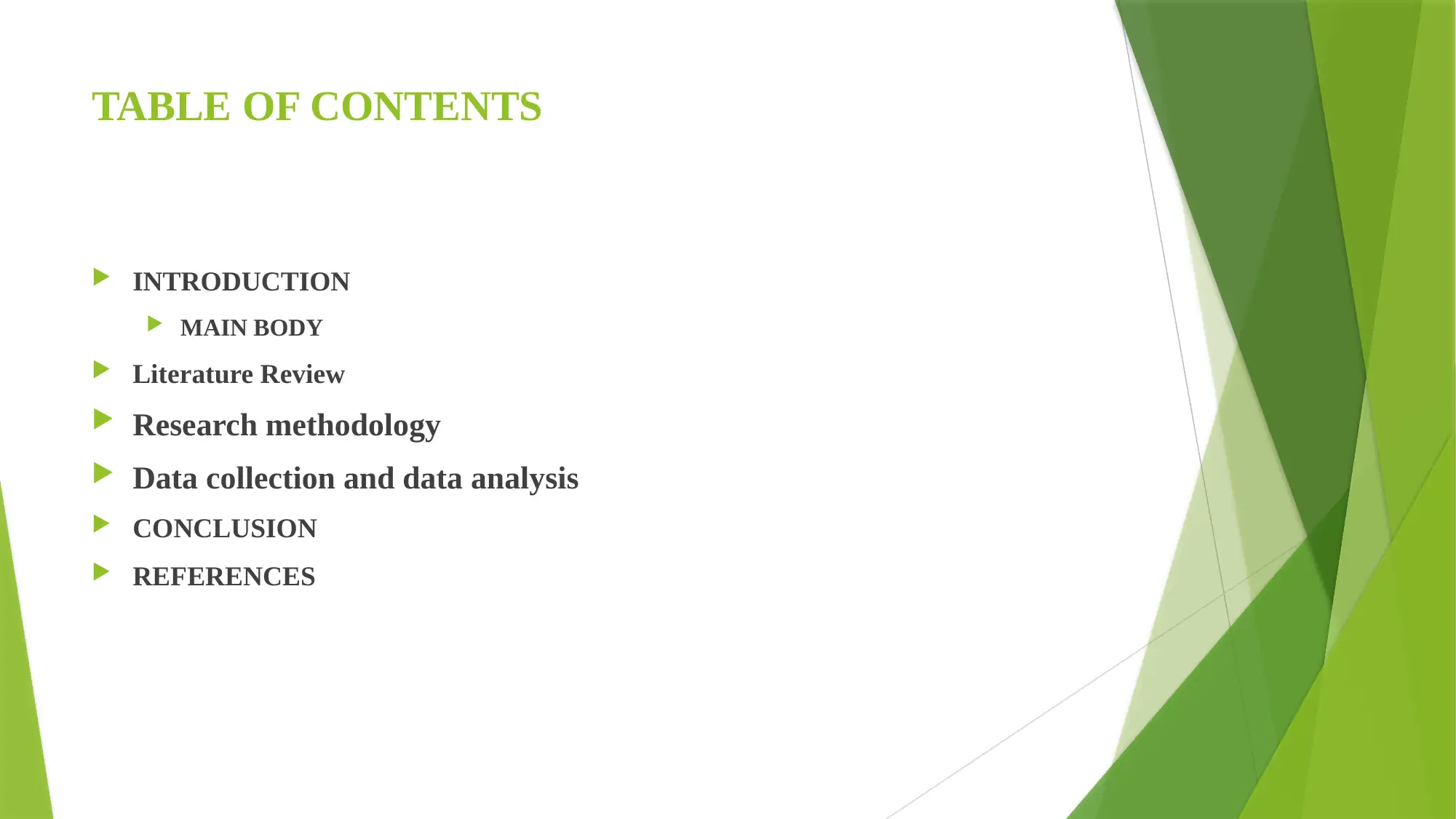
TABLE OF CONTENTS
INTRODUCTION
MAIN BODY
Literature Review
Research methodology
Data collection and data analysis
CONCLUSION
REFERENCES
INTRODUCTION
MAIN BODY
Literature Review
Research methodology
Data collection and data analysis
CONCLUSION
REFERENCES
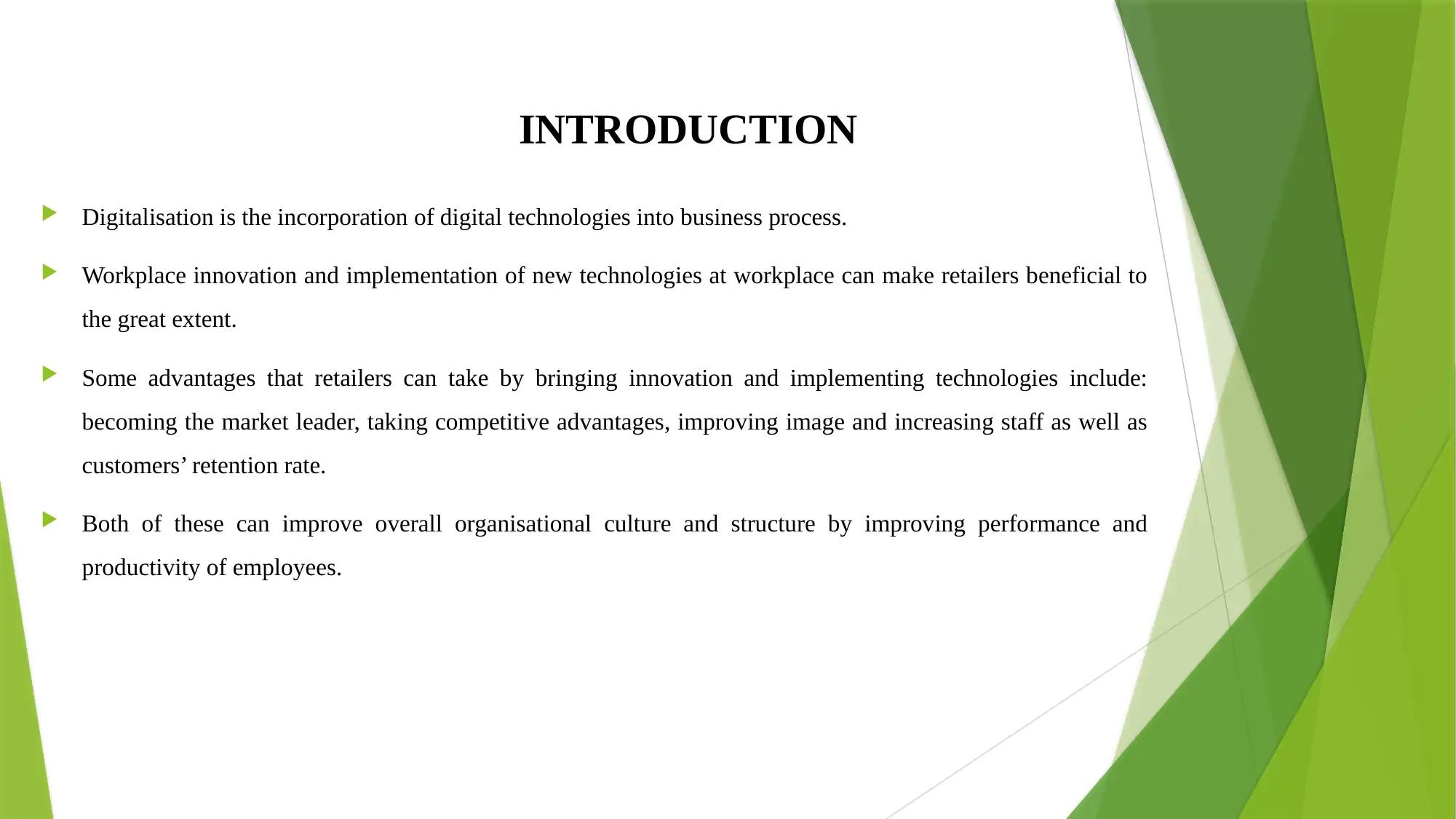
INTRODUCTION
Digitalisation is the incorporation of digital technologies into business process.
Workplace innovation and implementation of new technologies at workplace can make retailers beneficial to
the great extent.
Some advantages that retailers can take by bringing innovation and implementing technologies include:
becoming the market leader, taking competitive advantages, improving image and increasing staff as well as
customers’ retention rate.
Both of these can improve overall organisational culture and structure by improving performance and
productivity of employees.
Digitalisation is the incorporation of digital technologies into business process.
Workplace innovation and implementation of new technologies at workplace can make retailers beneficial to
the great extent.
Some advantages that retailers can take by bringing innovation and implementing technologies include:
becoming the market leader, taking competitive advantages, improving image and increasing staff as well as
customers’ retention rate.
Both of these can improve overall organisational culture and structure by improving performance and
productivity of employees.
⊘ This is a preview!⊘
Do you want full access?
Subscribe today to unlock all pages.

Trusted by 1+ million students worldwide
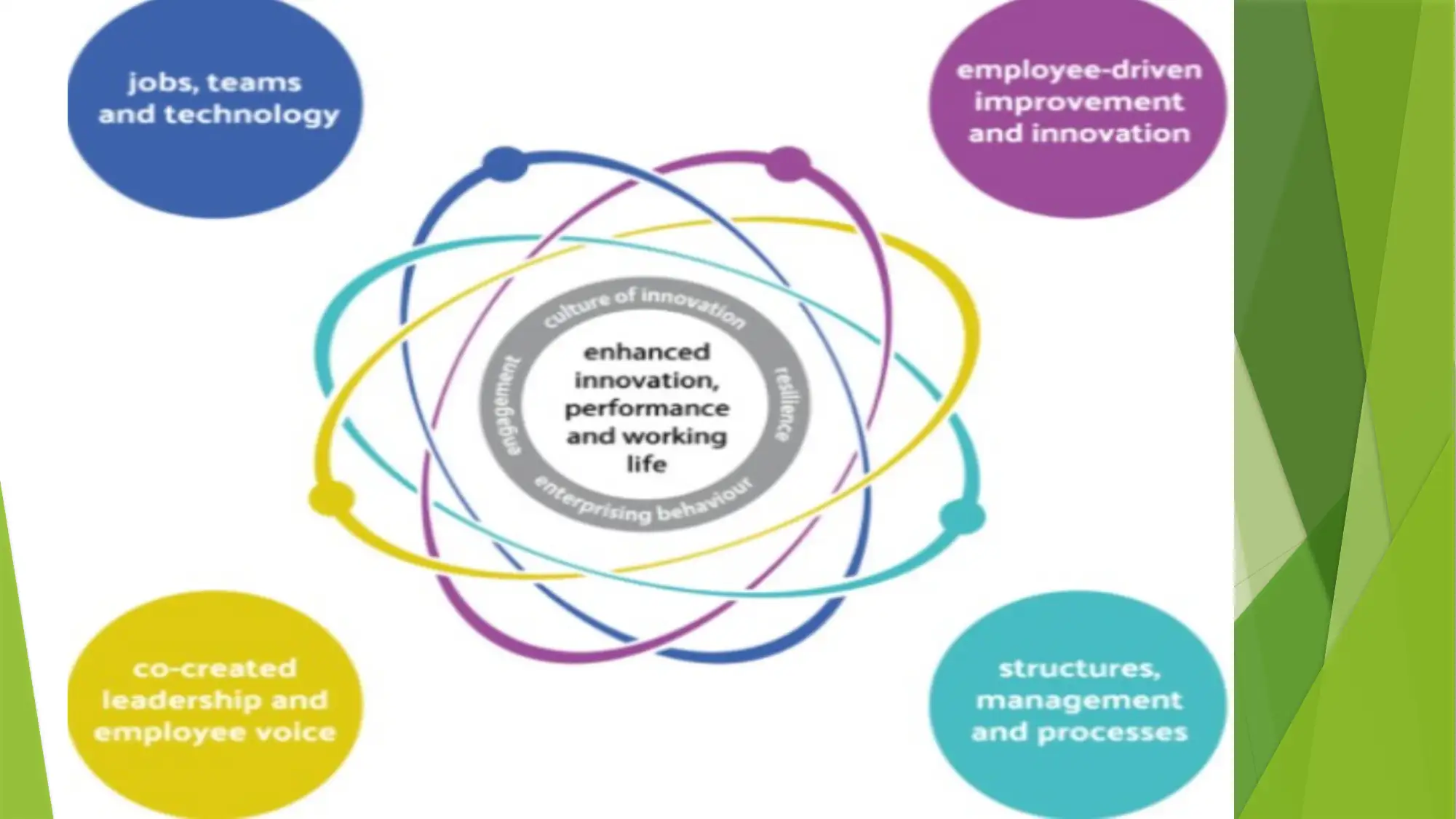
Paraphrase This Document
Need a fresh take? Get an instant paraphrase of this document with our AI Paraphraser
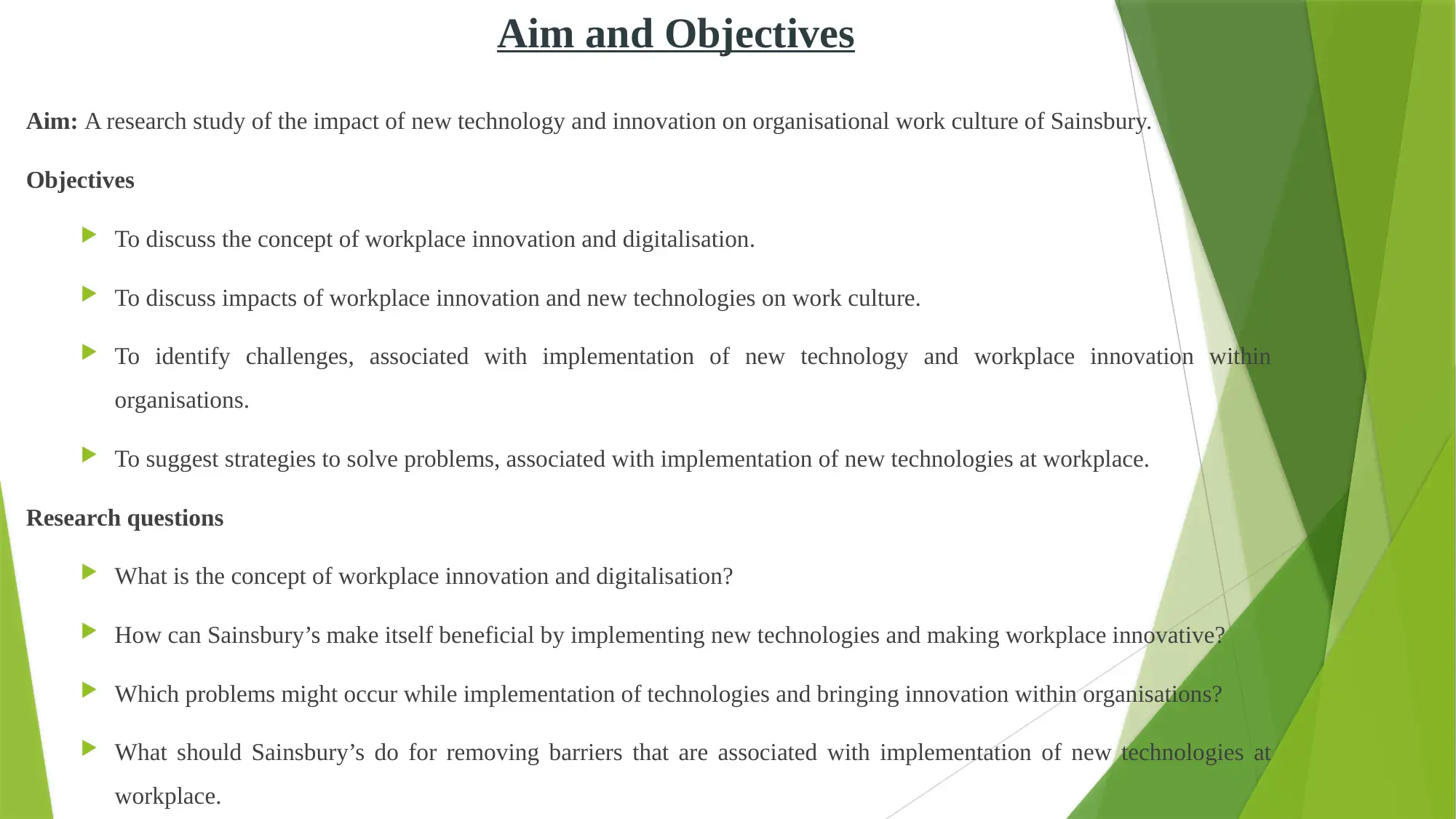
Aim and Objectives
Aim: A research study of the impact of new technology and innovation on organisational work culture of Sainsbury.
Objectives
To discuss the concept of workplace innovation and digitalisation.
To discuss impacts of workplace innovation and new technologies on work culture.
To identify challenges, associated with implementation of new technology and workplace innovation within
organisations.
To suggest strategies to solve problems, associated with implementation of new technologies at workplace.
Research questions
What is the concept of workplace innovation and digitalisation?
How can Sainsbury’s make itself beneficial by implementing new technologies and making workplace innovative?
Which problems might occur while implementation of technologies and bringing innovation within organisations?
What should Sainsbury’s do for removing barriers that are associated with implementation of new technologies at
workplace.
Aim: A research study of the impact of new technology and innovation on organisational work culture of Sainsbury.
Objectives
To discuss the concept of workplace innovation and digitalisation.
To discuss impacts of workplace innovation and new technologies on work culture.
To identify challenges, associated with implementation of new technology and workplace innovation within
organisations.
To suggest strategies to solve problems, associated with implementation of new technologies at workplace.
Research questions
What is the concept of workplace innovation and digitalisation?
How can Sainsbury’s make itself beneficial by implementing new technologies and making workplace innovative?
Which problems might occur while implementation of technologies and bringing innovation within organisations?
What should Sainsbury’s do for removing barriers that are associated with implementation of new technologies at
workplace.
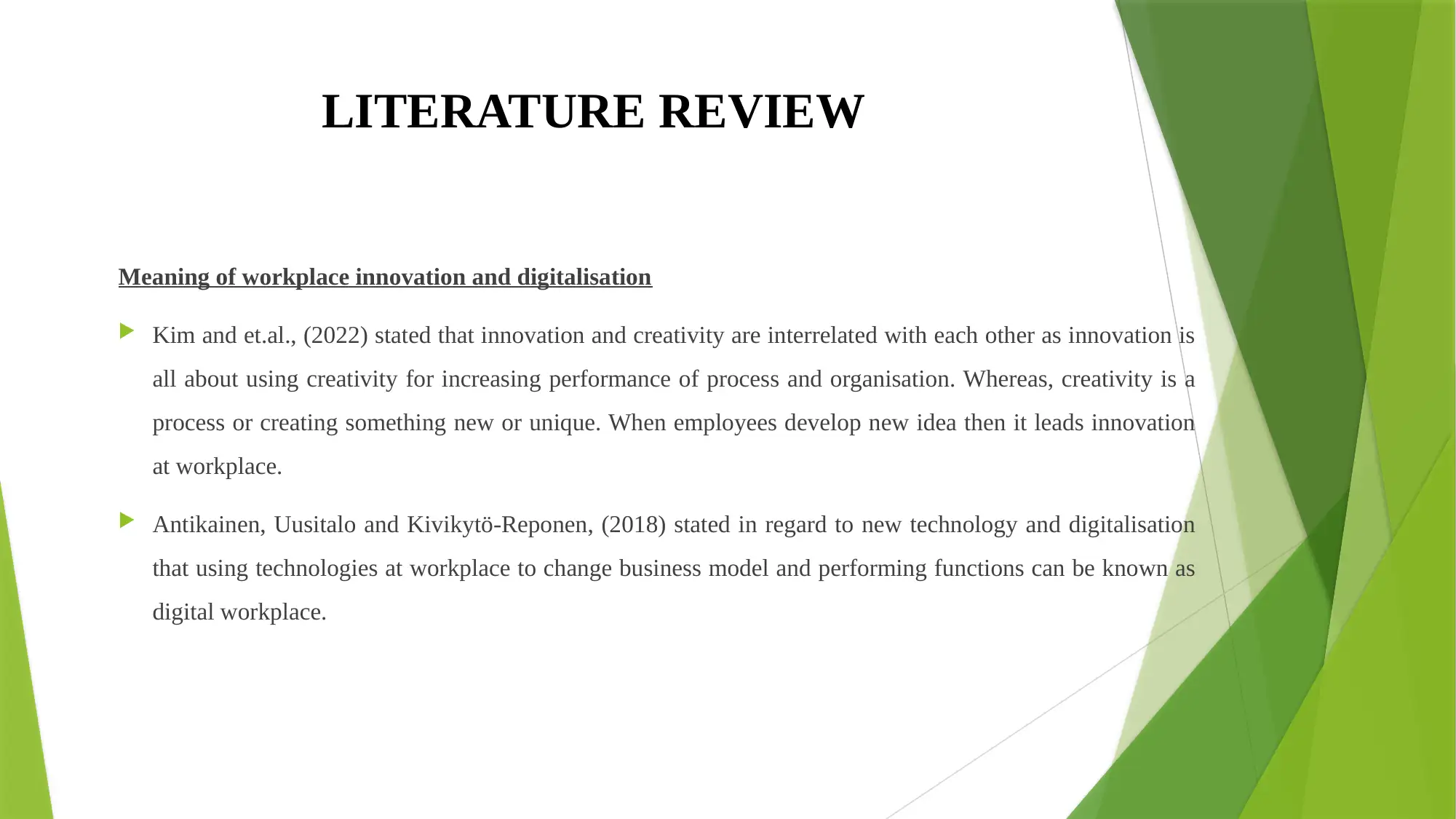
LITERATURE REVIEW
Meaning of workplace innovation and digitalisation
Kim and et.al., (2022) stated that innovation and creativity are interrelated with each other as innovation is
all about using creativity for increasing performance of process and organisation. Whereas, creativity is a
process or creating something new or unique. When employees develop new idea then it leads innovation
at workplace.
Antikainen, Uusitalo and Kivikytö-Reponen, (2018) stated in regard to new technology and digitalisation
that using technologies at workplace to change business model and performing functions can be known as
digital workplace.
Meaning of workplace innovation and digitalisation
Kim and et.al., (2022) stated that innovation and creativity are interrelated with each other as innovation is
all about using creativity for increasing performance of process and organisation. Whereas, creativity is a
process or creating something new or unique. When employees develop new idea then it leads innovation
at workplace.
Antikainen, Uusitalo and Kivikytö-Reponen, (2018) stated in regard to new technology and digitalisation
that using technologies at workplace to change business model and performing functions can be known as
digital workplace.
⊘ This is a preview!⊘
Do you want full access?
Subscribe today to unlock all pages.

Trusted by 1+ million students worldwide
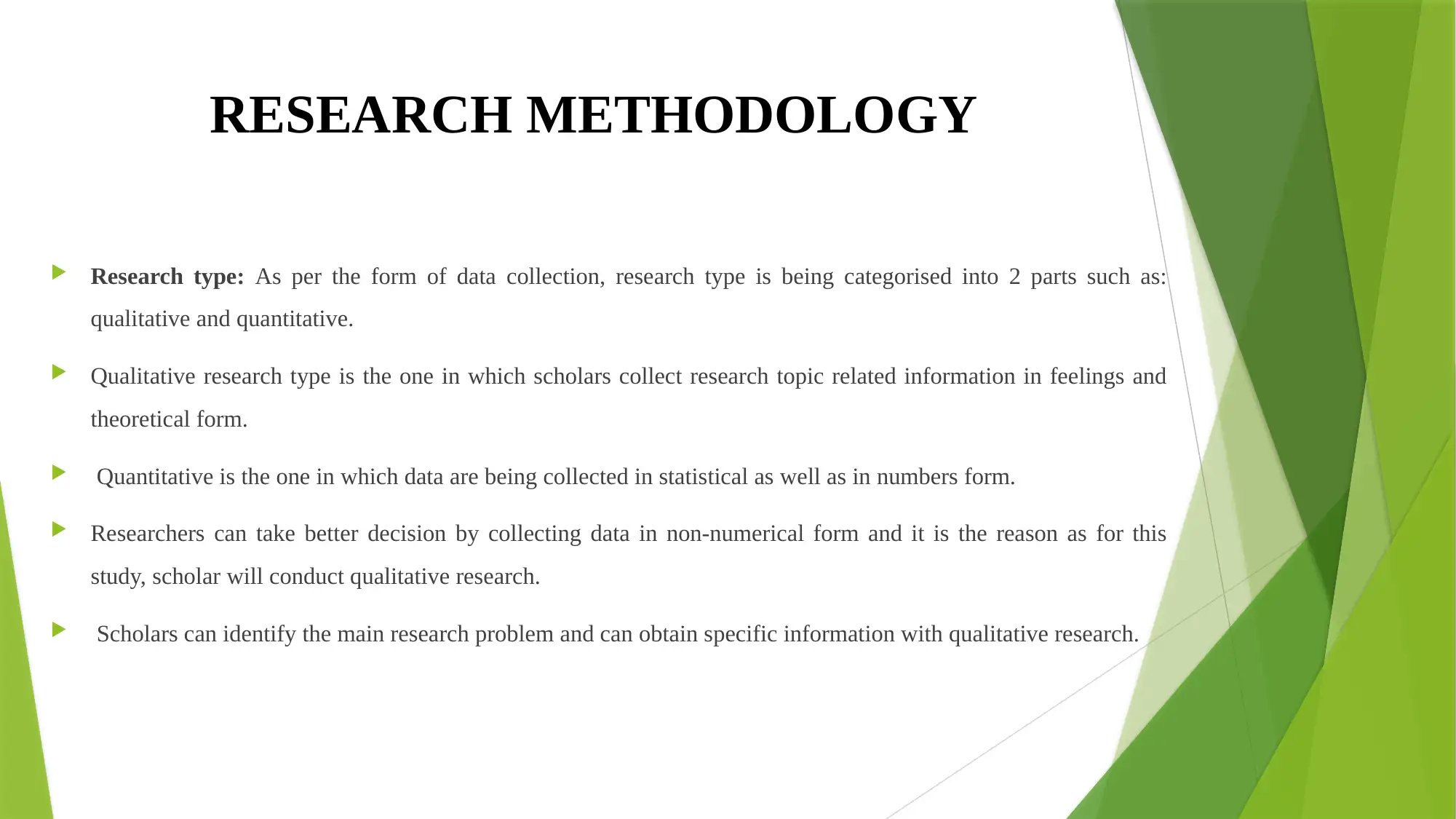
RESEARCH METHODOLOGY
Research type: As per the form of data collection, research type is being categorised into 2 parts such as:
qualitative and quantitative.
Qualitative research type is the one in which scholars collect research topic related information in feelings and
theoretical form.
Quantitative is the one in which data are being collected in statistical as well as in numbers form.
Researchers can take better decision by collecting data in non-numerical form and it is the reason as for this
study, scholar will conduct qualitative research.
Scholars can identify the main research problem and can obtain specific information with qualitative research.
Research type: As per the form of data collection, research type is being categorised into 2 parts such as:
qualitative and quantitative.
Qualitative research type is the one in which scholars collect research topic related information in feelings and
theoretical form.
Quantitative is the one in which data are being collected in statistical as well as in numbers form.
Researchers can take better decision by collecting data in non-numerical form and it is the reason as for this
study, scholar will conduct qualitative research.
Scholars can identify the main research problem and can obtain specific information with qualitative research.
Paraphrase This Document
Need a fresh take? Get an instant paraphrase of this document with our AI Paraphraser
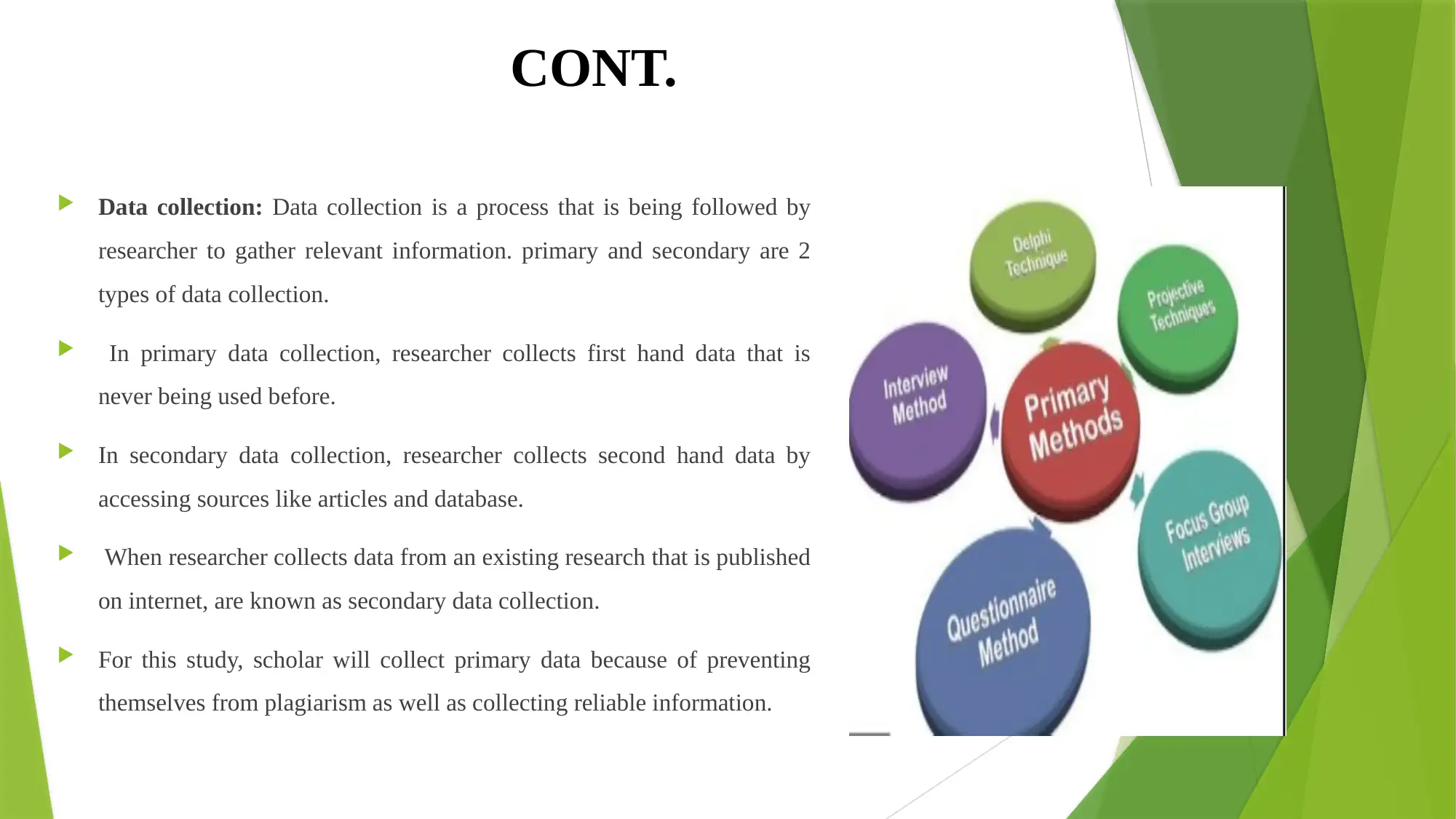
CONT.
Data collection: Data collection is a process that is being followed by
researcher to gather relevant information. primary and secondary are 2
types of data collection.
In primary data collection, researcher collects first hand data that is
never being used before.
In secondary data collection, researcher collects second hand data by
accessing sources like articles and database.
When researcher collects data from an existing research that is published
on internet, are known as secondary data collection.
For this study, scholar will collect primary data because of preventing
themselves from plagiarism as well as collecting reliable information.
Data collection: Data collection is a process that is being followed by
researcher to gather relevant information. primary and secondary are 2
types of data collection.
In primary data collection, researcher collects first hand data that is
never being used before.
In secondary data collection, researcher collects second hand data by
accessing sources like articles and database.
When researcher collects data from an existing research that is published
on internet, are known as secondary data collection.
For this study, scholar will collect primary data because of preventing
themselves from plagiarism as well as collecting reliable information.
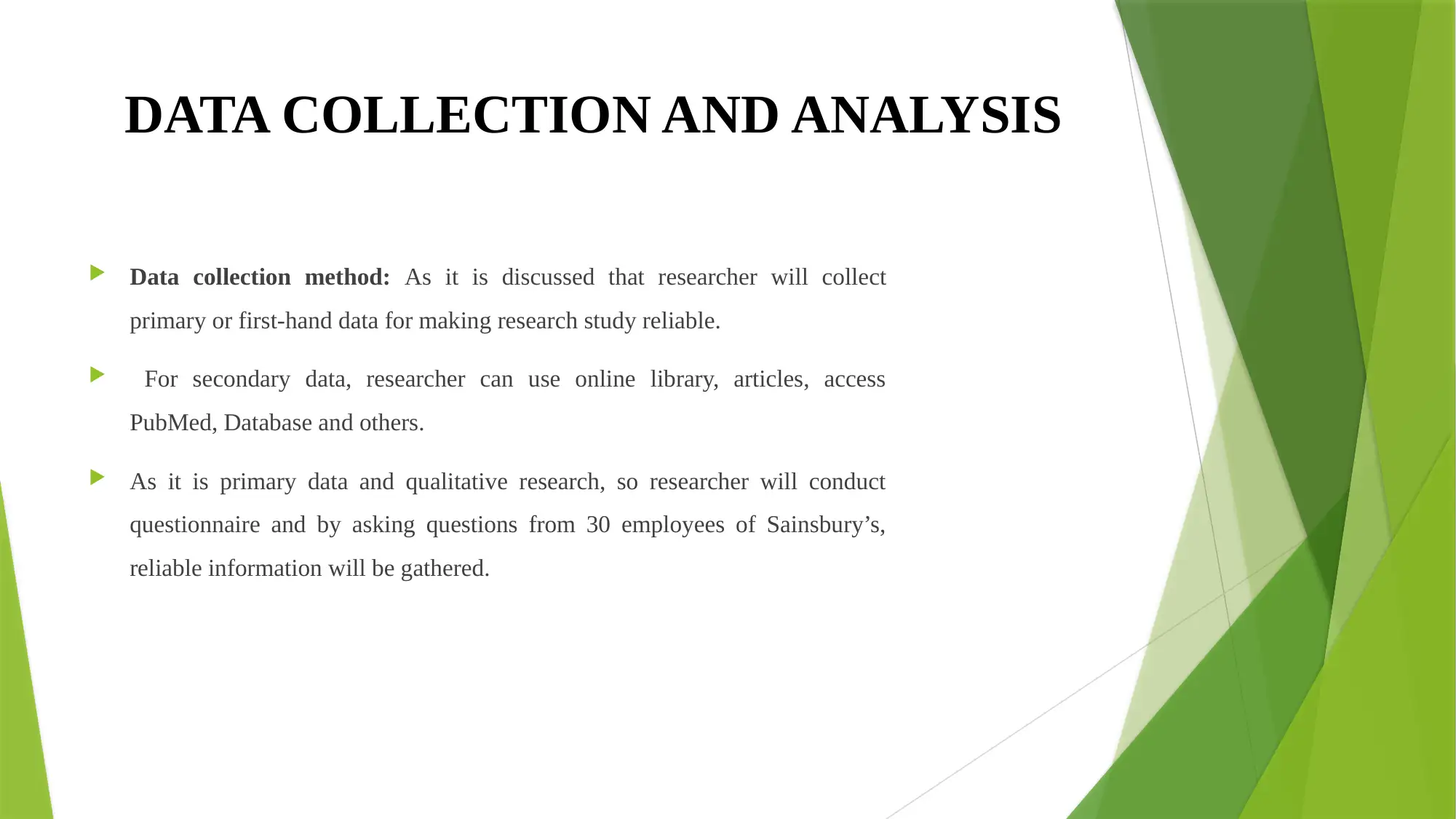
DATA COLLECTION AND ANALYSIS
Data collection method: As it is discussed that researcher will collect
primary or first-hand data for making research study reliable.
For secondary data, researcher can use online library, articles, access
PubMed, Database and others.
As it is primary data and qualitative research, so researcher will conduct
questionnaire and by asking questions from 30 employees of Sainsbury’s,
reliable information will be gathered.
Data collection method: As it is discussed that researcher will collect
primary or first-hand data for making research study reliable.
For secondary data, researcher can use online library, articles, access
PubMed, Database and others.
As it is primary data and qualitative research, so researcher will conduct
questionnaire and by asking questions from 30 employees of Sainsbury’s,
reliable information will be gathered.
⊘ This is a preview!⊘
Do you want full access?
Subscribe today to unlock all pages.

Trusted by 1+ million students worldwide
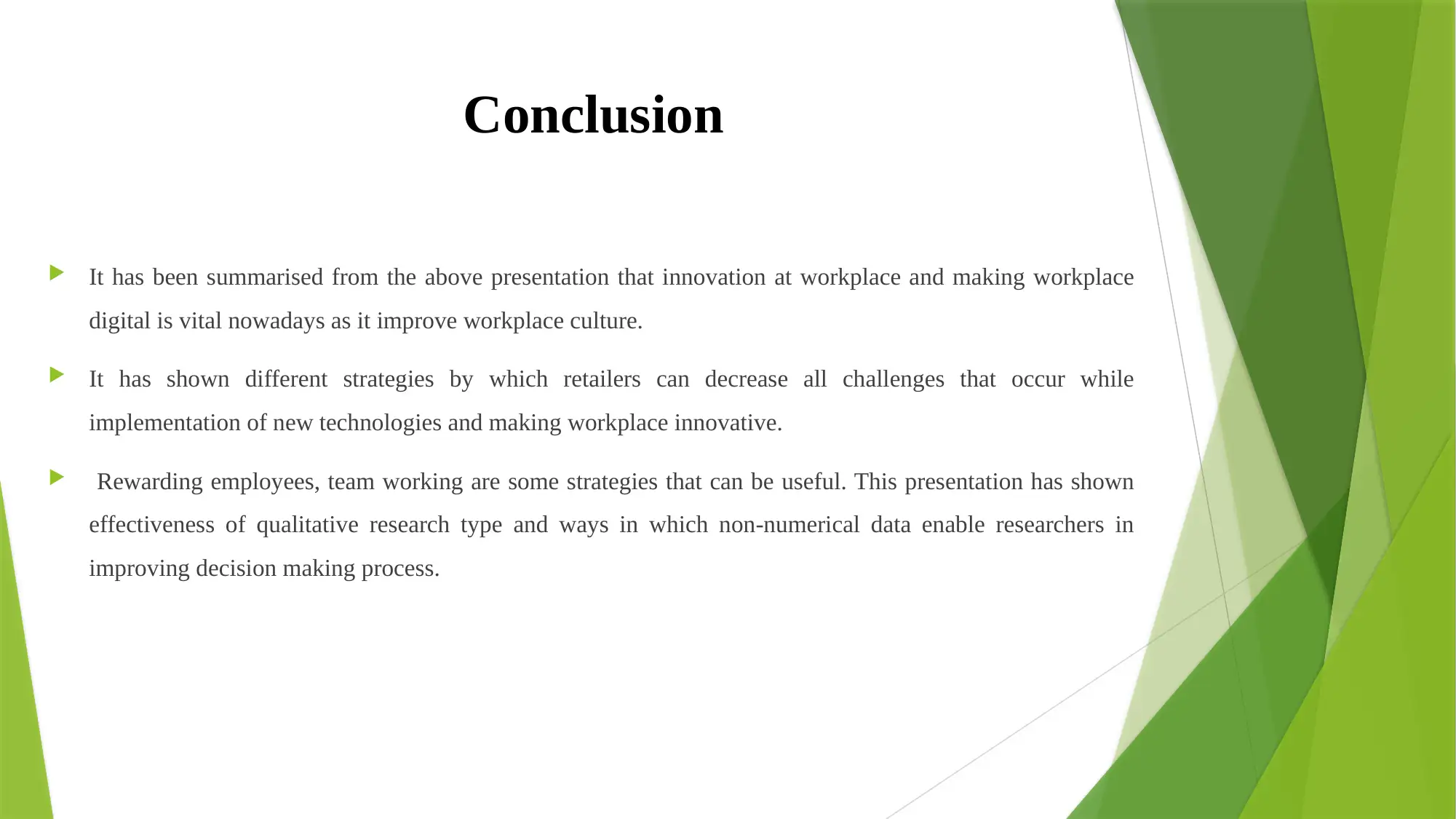
Conclusion
It has been summarised from the above presentation that innovation at workplace and making workplace
digital is vital nowadays as it improve workplace culture.
It has shown different strategies by which retailers can decrease all challenges that occur while
implementation of new technologies and making workplace innovative.
Rewarding employees, team working are some strategies that can be useful. This presentation has shown
effectiveness of qualitative research type and ways in which non-numerical data enable researchers in
improving decision making process.
It has been summarised from the above presentation that innovation at workplace and making workplace
digital is vital nowadays as it improve workplace culture.
It has shown different strategies by which retailers can decrease all challenges that occur while
implementation of new technologies and making workplace innovative.
Rewarding employees, team working are some strategies that can be useful. This presentation has shown
effectiveness of qualitative research type and ways in which non-numerical data enable researchers in
improving decision making process.
Paraphrase This Document
Need a fresh take? Get an instant paraphrase of this document with our AI Paraphraser
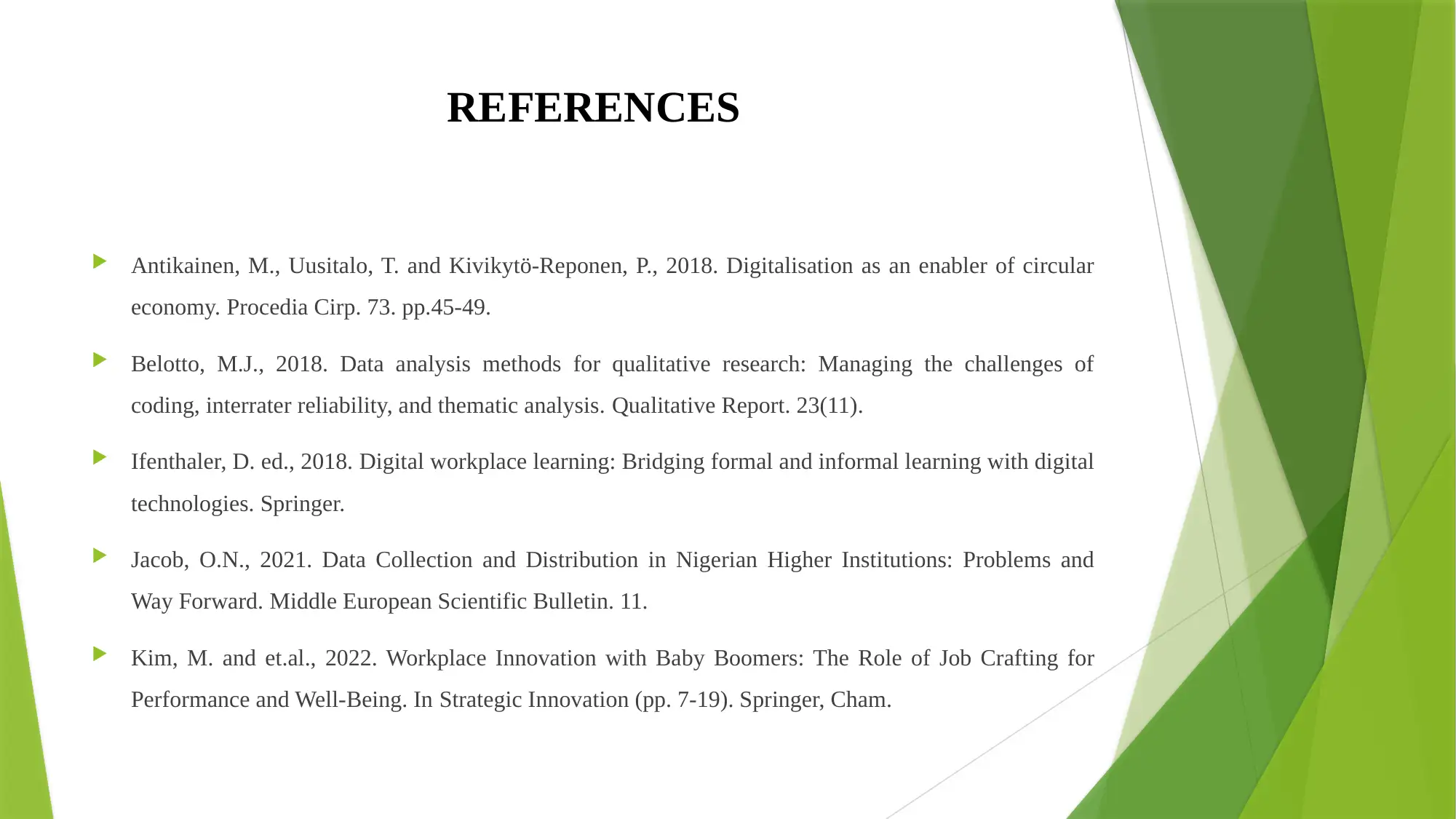
REFERENCES
Antikainen, M., Uusitalo, T. and Kivikytö-Reponen, P., 2018. Digitalisation as an enabler of circular
economy. Procedia Cirp. 73. pp.45-49.
Belotto, M.J., 2018. Data analysis methods for qualitative research: Managing the challenges of
coding, interrater reliability, and thematic analysis. Qualitative Report. 23(11).
Ifenthaler, D. ed., 2018. Digital workplace learning: Bridging formal and informal learning with digital
technologies. Springer.
Jacob, O.N., 2021. Data Collection and Distribution in Nigerian Higher Institutions: Problems and
Way Forward. Middle European Scientific Bulletin. 11.
Kim, M. and et.al., 2022. Workplace Innovation with Baby Boomers: The Role of Job Crafting for
Performance and Well-Being. In Strategic Innovation (pp. 7-19). Springer, Cham.
Antikainen, M., Uusitalo, T. and Kivikytö-Reponen, P., 2018. Digitalisation as an enabler of circular
economy. Procedia Cirp. 73. pp.45-49.
Belotto, M.J., 2018. Data analysis methods for qualitative research: Managing the challenges of
coding, interrater reliability, and thematic analysis. Qualitative Report. 23(11).
Ifenthaler, D. ed., 2018. Digital workplace learning: Bridging formal and informal learning with digital
technologies. Springer.
Jacob, O.N., 2021. Data Collection and Distribution in Nigerian Higher Institutions: Problems and
Way Forward. Middle European Scientific Bulletin. 11.
Kim, M. and et.al., 2022. Workplace Innovation with Baby Boomers: The Role of Job Crafting for
Performance and Well-Being. In Strategic Innovation (pp. 7-19). Springer, Cham.

⊘ This is a preview!⊘
Do you want full access?
Subscribe today to unlock all pages.

Trusted by 1+ million students worldwide
1 out of 12
Related Documents
Your All-in-One AI-Powered Toolkit for Academic Success.
+13062052269
info@desklib.com
Available 24*7 on WhatsApp / Email
![[object Object]](/_next/static/media/star-bottom.7253800d.svg)
Unlock your academic potential
Copyright © 2020–2025 A2Z Services. All Rights Reserved. Developed and managed by ZUCOL.




